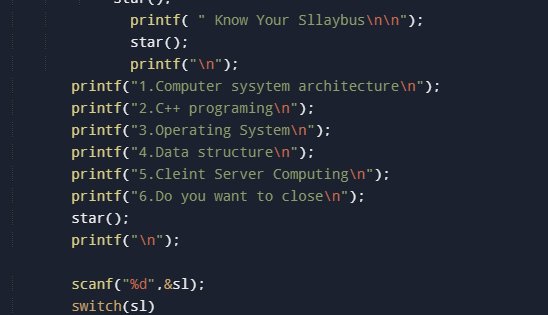Time Table Management System in C Programming
Time Table Management System in C Programming

The Time Table Management System is a project developed using the C programming language to facilitate efficient scheduling and information retrieval for an academic institution. This program primarily focuses on managing and displaying a semester's timetable, allowing users to access schedules and related data with ease. Below is an overview of its design, functionality, and implementation.
Key Features
-
Login System
The program begins with a login form requiring a username and password. The credentials are hardcoded for simplicity:- Username:
manuu - Password:
mca2sem
Upon successful login, users are greeted and can navigate the system.
- Username:
-
Timetable Navigation
The system provides a day-wise timetable breakdown for the semester. The available options include:- Viewing class schedules for days like Monday through Friday.
- Accessing information about holidays on Saturdays and Sundays.
- Retrieving information about professors, their schedules, and syllabus.
-
Professor-Specific Information
Users can view details about classes taught by specific professors, such as:- Timings and days of lectures.
- Subjects handled by each faculty member.
-
Utilities
Additional utilities include:- Syllabus management, where users can view topics of various subjects.
- Attendance calculation by entering attended and total classes.
- Conversion of CGPA to percentage marks.
-
File Handling for Syllabus
The program uses text files (e.g.,csa1.txt,cpp1.txt) to store syllabus content for various units. These files are read dynamically when the user selects specific units in the syllabus section.
Code Overview
-
Modules and Functions
The system is modularized with clear functions for specific tasks:- Decoration Functions: (
star(),equl(),flin()) add visual appeal. - Timetable Functions: (
mond(),tues(),wedness(), etc.) display day-specific schedules. - Subject-Specific Functions: (
deal(),t_ar(),fare(), etc.) provide detailed schedules for subjects.
- Decoration Functions: (
-
Switch Cases for Navigation
The program usesswitch-casestatements for menu-driven navigation, enabling users to choose their desired functionality. -
File I/O
File operations (fopen,fgets,fclose) are used to fetch syllabus details. Each subject and unit has a dedicated text file, allowing dynamic content updates without modifying the core code. -
Control Flow
Nested loops (do-while) are utilized to allow continuous operation until the user opts to exit. This ensures seamless navigation and user engagement.
Program Highlights
- Interactive Design: The use of star and equal-line decorations adds a user-friendly interface to the otherwise text-based program.
- Comprehensive Timetable: Detailed schedules for classes, labs, and holidays ensure full visibility for users.
- Syllabus Integration: File-based storage makes syllabus updates easy and flexible.
- Educational Utility: Tools like attendance calculation and CGPA-to-percentage conversion assist students in academic planning.
Limitations and Future Scope
- Hardcoded Credentials
The current login system is basic and can be replaced with a more secure mechanism. - Static Data
Timetables and professor details are static. A database-driven approach could provide more scalability and real-time updates. - User Interface
While functional, the text-based interface can be improved with graphical libraries like GTK or Qt for a better user experience.
Conclusion
The Time Table Management System is a robust tool for managing academic schedules and resources. Its structured design and modularity make it a valuable educational project for learning file handling, modular programming, and menu-driven interfaces in C. With enhancements, it could evolve into a more dynamic and scalable solution.
Files
What's Your Reaction?


















